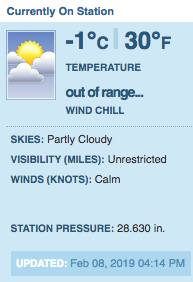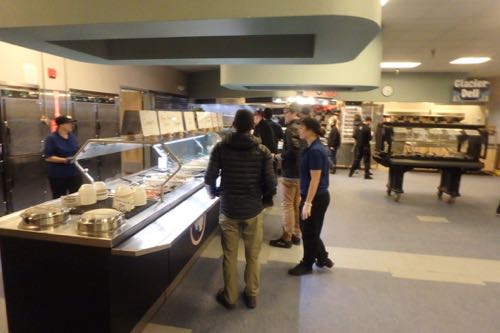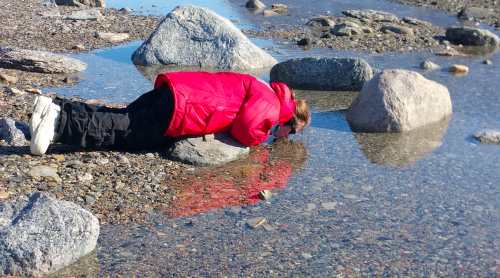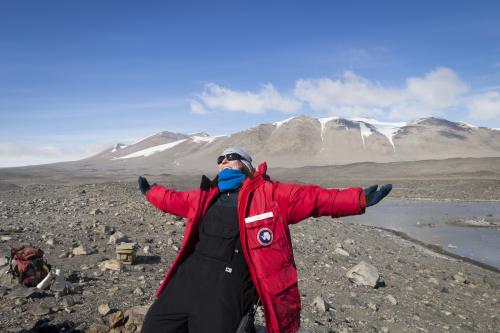 In this episode of "Meet the Scientist", you will meet Alissa Pike. Her story is below.
In this episode of "Meet the Scientist", you will meet Alissa Pike. Her story is below.
Weather: Probably nicer than most places in the United States.
 Blue skies, unlimited visibility, sunshine, no wind, and temps almost to freezing. Time for the shorts and flip flops.
Blue skies, unlimited visibility, sunshine, no wind, and temps almost to freezing. Time for the shorts and flip flops.
Menu from the McMurdo Galley:
 Here is a typical menu from the Galley here at the McMurdo Station.
Here is a typical menu from the Galley here at the McMurdo Station.
We received word today that our trip here to Antarctica will be extended. We've been here this long, an extra day or two won't make much of a difference. Our weather here has delayed the off-loading and on-loading of our cargo ship. That might be our delay as they try and get the NAVCHAPS (the folks who are brought here to to load/off-load the vessel) home in a timely manner. Any weather delays, which happens every other day, could extend our stay here even longer. Let me show you around the Galley and you will see why I am not real worried about extending my stay on the ice.
Tour the Galley
 In order to prevent the "McMurdo Crud" from spreading, everyone must stop at this hand washing station prior to entering the Galley.
In order to prevent the "McMurdo Crud" from spreading, everyone must stop at this hand washing station prior to entering the Galley.
 Here is the main line in the Galley. Warm vegetables and the main courses are here.
Here is the main line in the Galley. Warm vegetables and the main courses are here.
 Here were just a few of our choices for dinner tonight.
Here were just a few of our choices for dinner tonight.
 My breakfast: Smoked salmon with capers, flank steak, fresh melon and pineapple, cod, assorted cheeses, green olives.
My breakfast: Smoked salmon with capers, flank steak, fresh melon and pineapple, cod, assorted cheeses, green olives.
 This is how you can tell the supply vessel has arrived. We have "Freshies". Check out the lettuce, tomatoes, cucumbers, and cabbage. We haven't seen this type of food for a while.
This is how you can tell the supply vessel has arrived. We have "Freshies". Check out the lettuce, tomatoes, cucumbers, and cabbage. We haven't seen this type of food for a while.
 This was my very tasty, made to order (I just had everything on it), omelette.
This was my very tasty, made to order (I just had everything on it), omelette.
 Here are some of our dessert choices for the night.
Here are some of our dessert choices for the night.
 This is the center island of the Galley. Here we find very good cookies, and occasional fresh fruit, waffle maker, cereal, and other warm items.
This is the center island of the Galley. Here we find very good cookies, and occasional fresh fruit, waffle maker, cereal, and other warm items.
 This is the Grab and Go cooler. It is so easy to pack a lunch in the morning if we are flying out into the field for the day. All different types of sandwiches are placed in here.
This is the Grab and Go cooler. It is so easy to pack a lunch in the morning if we are flying out into the field for the day. All different types of sandwiches are placed in here.
 Here at The Grill, you get burgers, burritos, Mongolian BBQ, and other things grilled to order.
Here at The Grill, you get burgers, burritos, Mongolian BBQ, and other things grilled to order.
 The Mongolian BBQ was the best!
The Mongolian BBQ was the best!
 Another view of our wonderful Galley.
Another view of our wonderful Galley.
 At Glacier Deli, you don your own gloves and get behind the counter and make your own sub sandwich with all the fixings.
At Glacier Deli, you don your own gloves and get behind the counter and make your own sub sandwich with all the fixings.
 Here is one thing I don't like about the Galley.
Here is one thing I don't like about the Galley.
 At the end of our great meals, we show appreciation to our wonderful support staff by bussing our own tables and taking our dirty dishes to the dishwashing staff. Very friendly folks.
At the end of our great meals, we show appreciation to our wonderful support staff by bussing our own tables and taking our dirty dishes to the dishwashing staff. Very friendly folks.
Here is our first episode of "Meet The Scientist". Today, meet Alyssa Pike.
 Alyssa Pike taking a drink from a melt pond in the field. Dr. Adams did it first. (Photo by Dr. Thomas Powers)
Alyssa Pike taking a drink from a melt pond in the field. Dr. Adams did it first. (Photo by Dr. Thomas Powers)
Hello PolarTREC friends and followers! My name is Alyssa Pike, I’m one of the wormherders that you’ve seen around in Kevin’s various posts. Kevin asked me to tell you a little bit about myself and how I got myself stuck at the bottom of the world with a bunch of weirdos for six weeks. Uh – I mean – how I came across this incredible opportunity! Seriously though, I’ve loved my time here and I couldn’t have asked for better people to be working with.
 This cat likes me, I promise.
This cat likes me, I promise.
So this is me! I’m 22 years old, from Arizona and I’m a junior in my undergraduate degree at Brigham Young University studying Molecular Biology. When I’m not in Antarctica or buried in homework, I like to play volleyball and tennis and I’m pretty big on hiking, although I don’t get out as much as I’d like to. I’m an English minor so I love reading and writing. On the weekends I’m a part of BYU’s improv comedy group, so I spend a lot of time making stuff up and making a fool of myself with my friends. My favorite T.V. show is Star Trek (The Original Series, thank you very much. Captain Kirk forever), I’m 100% on board the Marvel bandwagon and very excited for Avengers: Endgame to come out.
 This is how we collect the soil samples in the Dry Valleys that we extract worms from back in the lab. I really need to do more stretching. (Photo by Tasha Griffin)
This is how we collect the soil samples in the Dry Valleys that we extract worms from back in the lab. I really need to do more stretching. (Photo by Tasha Griffin)
I took a bit of an interesting road to get to where I am today. When I was in elementary school, I was obsessed with ants. Don’t ask me how it happened, I don’t know. I just know that if you’d asked me what I wanted to be when I grew up, I’d tell you that I wanted to be an entomologist (bug scientist) and study ants. When I was 12, I got a microscope for my birthday and made my own slides from plants in my back yard. Things got a little tricky when I went to junior high. I was pretty undeniably myself, science and all, but I had a few "friends" that weren’t cool with that. I decided that I’d rather be myself than have friends who didn’t like who I was, so I didn’t have many friends. As much as I hung on to who I was, it hurt to have friends dump me like that and I got scared to show people the more outlandish parts of me. Unfortunately, that included science. From the time I was 13-17, no one really knew that I liked science. Some of my closer friends might have had some idea, but I buried it so deep that even I forgot how much I loved it. Fortunately, I had a couple of great teachers that got me back on track. In 10th grade, I had a fantastic biology teacher that ignited the flame of my scientific curiosity again. Then in 11th grade, I had a chemistry teacher who had us do a biochemistry unit. I got to extract DNA from a strawberry and run some samples using molecular techniques like PCR and electrophoresis – and that was it, man. I couldn’t fight it anymore. It was scary, but I realized that science was a part of who I was, and I’d never really be me without it. So, I went from my senior year of high school with no one knowing that I liked science, to neck deep in a molecular biology degree with everyone knowing I liked science. I met Dr. Adams my first semester at BYU, and his rad way of talking about science totally knocked my socks off. I joined his research lab and after a few years of bugging him, and a year and a half off from school to serve a mission for my church, he finally let me come down to Antarctica with him. I’ve been having a fantastic time being a part of some really cool science. I never quite got tired of ants, so the plan is still to get a Ph.D. in entomology and study them. What can I say? Some things never change.
 My extremely professional reaction to being in the Dry Valleys for the first time. (Photo by Tasha Griffin)
My extremely professional reaction to being in the Dry Valleys for the first time. (Photo by Tasha Griffin)
Down here on the Ice, I’ve ended up managing most of the numbers we produce as a research team. Data entry and management are not the most glamorous parts of research, but without recording the numbers of worms and other animals in the samples we process, none of the work we do down here would mean anything. The data are what live on long after we leave Antarctica behind. They’re what Dr. Adams analyzes to see if there are trends in what kinds of animals live in different soils. Trends in the numbers lead to new questions, new projects and sometimes, if we’re lucky, really cool discoveries. But they can’t do anything if they’re not properly recorded and filed on the computer. We have to know what worms were in what soils, where those soils came from and what experiment they were a part of. Most importantly, we have to make sure that the numbers are entered correctly. Quality control is a big deal down here, because if numbers get entered incorrectly it could make Dr. Adams think that something cool is going on in the soil when really someone just put a ‘10’ where a ‘1’ should be. So, we double check everything that goes into the computer and keep multiple copies of all of our data sheets. That way, we can always go back to the original if something looks off, and Dr. Adams can write cool papers without worrying that his numbers are bogus. It’s not the most epic thing to do, but it’s an important cog in the research wheel.
Kevin has done an awesome job of describing everything else that’s going on down here, so I thought I’d tell you a little bit about the astrobiology research I’m doing back home. Without getting into too much detail, I’m looking at whether these awesome Antarctic worms we’re working with could possibly survive on Mars if we gave them a bit of a head start. I’m taking a certain species of worm that survives really well in the harsh environment on this continent (Scottnema lindsayae, for those of you who’ve been paying attention) and putting them into some “soil” that’s about as close to Martian dirt as we can make on Earth, only I’m adding some nutrients that are essential for life like carbon, nitrogen and phosphorous (a lot like that F6 stoichiometry experiment) and about as much water as you’d find in these Antarctic soils. I’ll make sure they have some bacteria to eat, and then I’ll leave them alone to see how they do! I haven’t done any of these tests yet – that’s the first thing on my to-do list when I get back from the Ice, but I’m pretty excited about it.
That’s it for me, guys! If you only take one thing away from my post tonight, I hope it’s this: When you stick to who you are and follow your dreams, cool stuff happens. Cooler than you could have imagined for yourself. You can do anything that you want to do. So take some chances, get a little messy, and make some mistakes. You got this.


Comments
Add new comment